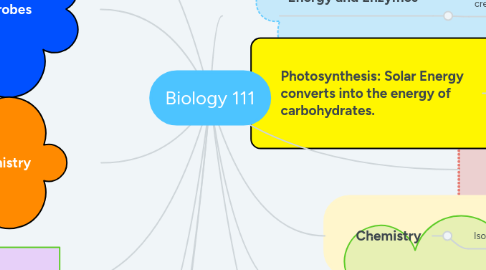
1. Scientific Method:
1.1. Observe
1.1.1. Question
1.1.1.1. Hypothesize
1.1.1.1.1. Predict
2. Microbes
2.1. Prokaryotes: Single-celled organism that has neither a distinct nucleus with a membrane nor other specified organelles. Has bacteria and cyanobacteria.
2.1.1. Eukaryotes: An organism consisting of one or more cells in which the genetic material, which is DNA in the form of chromosomes contained within a nucleus. Includes all living organisms other than the eubacteria and archaebacteria.
3. Organic Chemistry
3.1. Carbohydrates
3.1.1. Lipids
3.1.1.1. Proteins
3.1.1.1.1. Nucleic Acids
4. Cell Membrane
4.1. Mitosis
4.1.1. Meiosis
4.1.1.1. Diffusion
5. Cellular Respiration
5.1. Cell Division
5.1.1. Synthesis of proteins from Amino Acids
5.1.1.1. Active Transport
5.1.1.1.1. Muscle Cell Contractions (Animals Only)
6. Cell Division Mitosis and Meoisis
6.1. Stages of mitosis: Prophase, Metaphase, Anaphase and Telophase
6.1.1. Stages of Meiosis: Meiosis Stage 1: Prophase 1,Metaphase 1, Anaphase 1, Telophase 1, Interkinesis
6.1.1.1. Stages of Meiosis Stage 2: Prophase ll, Metaphase ll, Anaphase ll, Telophase ll.
7. Ecology
7.1. Relation of organisms one with another
7.1.1. Naturalist: A person who studies natural history.
8. What is Science?
8.1. A systematic study of the structure of the physical and natural world through observation and experiment.tic
9. Chemistry
9.1. Isotope
9.1.1. radiation
9.1.1.1. Ionic Bond
9.1.1.1.1. Ionic and covalent bonding
10. Cell Biology
10.1. Macromolecules
10.1.1. Organelles and Endomembrane system
10.1.1.1. Mitochondria and Chloroplasts
11. Energy and Enzymes
11.1. Thermodynamics Law 1: Energy cannot be created or destroyed in an isolated system.
11.1.1. Thermodynamics Law 2: Entropy of any isolated system always increases.
11.1.1.1. Kinetic Energy:Energy in Motion
11.1.1.1.1. Chemical Energy: Form of potential energy that is stored within the chemical bonds of molecules.
12. Photosynthesis: Solar Energy converts into the energy of carbohydrates.
12.1. Mitochondria
12.1.1. Chloroplasts
13. Genitics
13.1. Homozygous: Has 2 Identical alleles at a locus.
13.1.1. Heterozygous: Has 2 different alleles at a locus.
